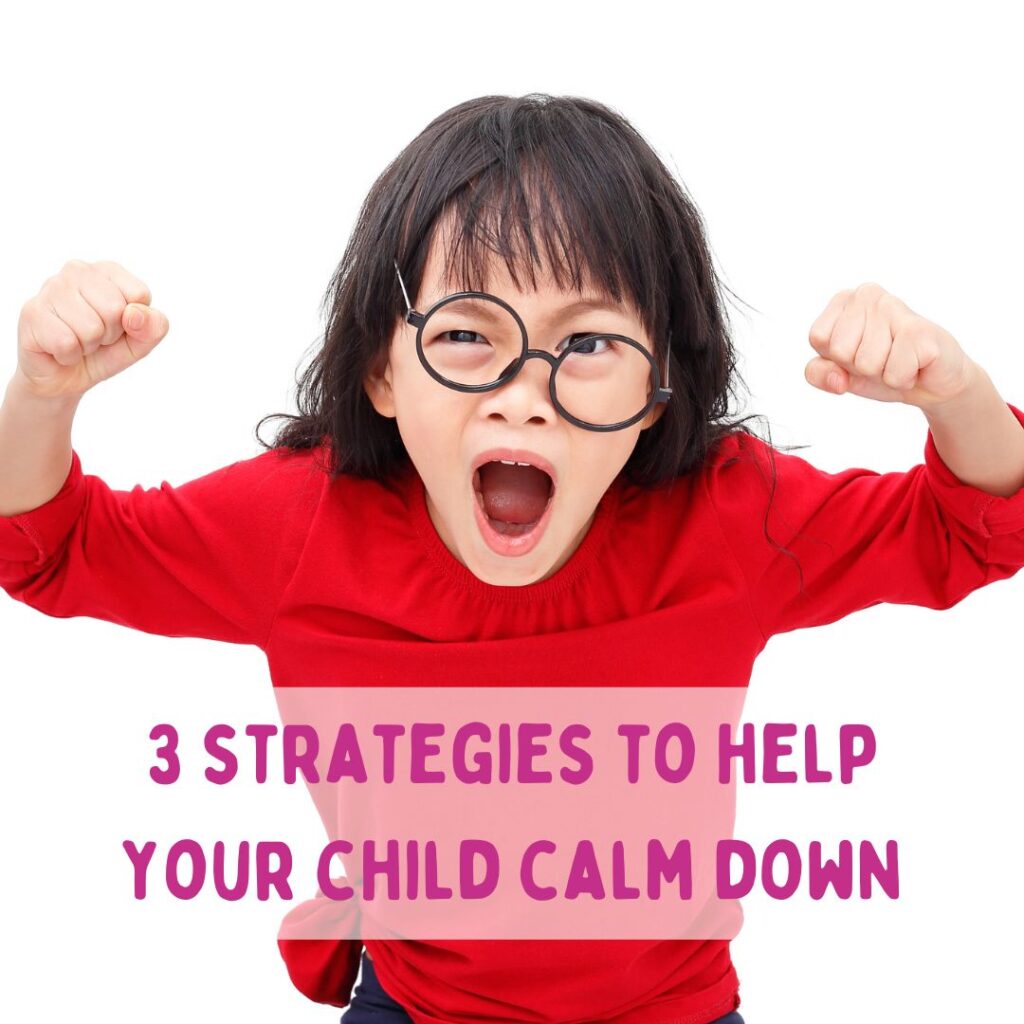Helping Kids Calm Down

In a previous blog post of mine – How to talk to your child about emotions – we talked about the importance of verbalising emotions and sharing our own feelings with our children so that they can understand and identify what they’re feeling. And while talking about emotions is vital, being able to name what they’re feeling doesn’t always help our children regulate their emotions and calm themselves down. So this week, I want to focus on exactly that – what we can do to help our kids calm down.
Before we jump in, I want to mention how important it is that we are supporting our children to calm themselves down, rather than needing our support every time. This is a long process, and I don’t know any child who is able to calm themselves down without mum, every time! But it’s a goal that we want our kids to be working towards. Unfortunately (or fortunately!), we can’t be with our kids every hour of every day, so we want them to have the tools and skills to support themselves. Below are a range of tools that we can teach our children to support them with their emotions. Most of them I use myself too!
It’s also important to remind our children that all emotions are okay to feel, so why we might want to calm down from them (because being overwhelmed by any feeling can be scary), it’s okay that we feel them!
3 Strategies to help your kids calm down
Recognise physical reactions
This was one that I actually only learned a few years ago. I’ve since done it in every single class I’ve had and it’s made such a difference.
Every emotion has a physical reaction on our body. Understanding and recognising that reaction can help us to become aware of our feelings, take us out of that initial reaction, and calm ourselves down.
For example, when I’m angry, my shoulders go up, my forehead creases, my heart rate speeds up and my eyes begin to burn (I cry when I’m angry. It’s very frustrating!). Equally, when I’m anxious, my shoulders go up, my eyebrows try to crawl into my hair and it feels harder to breath. Being aware of this (and in fact, taking the few seconds to recognise these reactions within my body) helps me to change the physical reactions: Lowering my shoulders, relaxing my forehead, taking the time to breath. Changing these physical reactions takes you out of that moment of overwhelm and helps you to control your emotions.
It’s exactly the same for our little ones. Encourage them to recognise how their emotions are effecting their bodies. Point out the visual ones and ask them questions about the ones you can’t see, for example, “How does your heart feel? How does your breath feel?” By identifying these things and being able to answer these questions, your little one has to focus on something other than what has made them angry.
Those few seconds gives them a chance to calm down, think more clearly and focus on what made them feel that way. Once they can verbalise what made them angry or scared (or whatever the big emotion is), they can begin to work on solving the problem.
Deep breathing
Taking a deep breath is one most people know about. Again, it does the same thing as the above, taking a second to think about something other than what has made your little one angry, upset, overwhelmed. One deep breath also helps children to control their physical reactions. It gets air into their lungs, which pauses that panic moment that can often happen for little ones when emotions get too big.
It also helps your child be able to talk. So often, I’ve seen children not be able to tell me what’s wrong because they’re too upset. Taking a breath and calming down just a little, makes it so much easier to solve whatever the problem is.
I often use the phrase “Take a deep breath for me, and then we can talk about it” so that they know why they’re taking a breath and that I am focusing on them and wanting to help. I like to put my hands flat out in front of me so that they can put their hands on mine as I model breathing. I move my hands up and down slowly, in time with my breaths. This gives an extra, sensory, element for your child to focus on. When they become more confident in this, they can move their hands for themselves, without adult support.
Count to calm down
If deep breathing isn’t helping, counting can be another option. Again, it focuses on something other than whatever has caused the big emotion. It’s particularly useful for children who need just a little bit more time. At first, try to count with your child to show you’re there to support them. When they’ve done this a few times, encourage them to count without you, but with you still physically there. The more experience they have with this, the easier they will find it to do by themselves.

Talk about strategies and use visuals to help your kids calm down
It’s really important to keep a dialogue about the strategies they can use to calm down, even when they’re not actively feeling those emotions. Books and stories can be really useful in creating these conversations as you can talk about characters and how they’re feeling, separating your child from the emotion, but still talking about strategies to help them calm down. This will help your child to remember them when they feel the same way.
Another support is using visuals. Cards with strategies on them are great for reminding your little one what they can do when they become overwhelmed, and having them easily accessible (or even up on walls where your child often is, such as the kitchen table, or where they play) can help them remember without your support.
Ask for their input / Self-reflection
Finally, it’s really useful to know your child’s opinion on these strategies. Are there certain ones that they find more useful than others? Are there ones that they don’t think help that much? Maybe there are other things that they’ve learned elsewhere that they want to try. Schools often have their own strategies to calm down, and you may want to include this when talking to your child about it to create consistency. Whatever you do, keeping an open dialogue with your child about emotions and how to deal with them will help them gain confidence and control over their emotions and lead to them finding it easier to calm down in the long run.
If you’ve found this helpful, feel free to look at my other blogs on the subject and join my Facebook group – Reading in Reception – where you can get additional tips and support for your Reception child!
If you’re really concerned about your child’s emotions and want extra help, check out this blog – When to seek help – verywellfamily.com